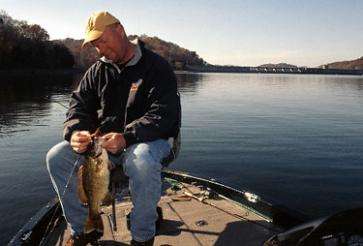
Everyone seems to think about falling water levels in the fall and winter when lake authorities start to draw reservoirs down in anticipation of spring rains. The truth is, falling water can happen almost anytime, including the middle of summer when demand for electricity is high.
I’ve noticed that recently on my home waters of Dale Hollow Lake here on the Tennessee-Kentucky border. It’s been a hot summer, and people are running their air conditioners long and hard. To match that demand for power, the turbines at the hydroelectric dam have to work overtime, and that means a lot of water is leaving the lake.
Now a lot of people look at a situation like falling water levels and see it as a problem, but not me. A problem is only a problem if you don’t have the solution. Once you know how bass — and especially smallmouth bass — react to certain conditions, these “problems” are just situations that you need to work on.
So when I look in the newspaper or otherwise notice that lake levels are steadily going down for a few days, I don’t see that as an excuse not to go fishing, and neither should you. I see it as my cue to locate the sharpest dropoffs I can find.
I’ve heard a lot of speculation as to why bass move to bluffs and sharp drops under falling water conditions — that they’re concerned about being left high and dry, that the falling water is less noticeable in these steeper areas, you name it — and I have to admit I have no idea why they move.
The important thing is that I know they move, and I know the kinds of places they move to. The rest doesn’t really matter.
And when the water’s falling, I go straight to the steepest bluffs and drops I can find. Typically, you’ll find them on the lower part of your favorite lake or reservoir. That’s where the deeper water is, and that’s where the steeper topography is usually found.
Falling water is a great excuse to pull out your best topographical map and look for the contour lines that come closest together. These are the places you’ll want to try.
Once you’re in your boat and motoring through the area, keep an eye on your electronics and identify the depth at which you see the most baitfish or bass activity. That’s where you’ll start your search. If you see most of the bait at 20 feet, expect to find the bass at the same depth or maybe a little deeper, suspended beneath them.
There are a couple of other things that you need to factor in during periods of falling water in the summer. One thing is the thermocline that band of water between the top layer that has lots of oxygen but high temperatures and the lower layer that has cooler temperatures but little oxygen. The thermocline has both cooler temperatures and good oxygen levels, and it’s where the bulk of the bass will be living.
When you rode across the water and looked for baitfish activity on your electronics, that depth level where you saw the most fish was probably the thermocline. It varies in depth from day to day or week to week and even from one area of the lake to another, so you’ll need to monitor that situation each time you hit the water.
Now, as the thermocline moves, the bass are going to move, too. And they’re going to concentrate in areas where they find structure and cover at the level of the thermocline. If you keep good records for a couple of years, you can often stay ahead of these fish and anticipate where they’ll go as the summer progresses, but you’ll have to keep track of things like water levels and thermocline range.
Next week, we’ll talk about baits and tactics that will take falling water smallmouth.
Until next time, if you have any questions or comments, I’d love to hear from you. Please e-mail me atStephen@thesmallmouthguru.com.





